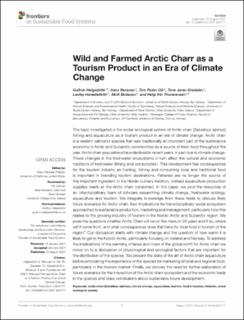| dc.contributor.author | Helgadóttir, Guðrún | |
| dc.contributor.author | Renssen, Hans | |
| dc.contributor.author | Olk, Tom Robin | |
| dc.contributor.author | Oredalen, Tone Jøran | |
| dc.contributor.author | Haraldsdóttir, Laufey | |
| dc.contributor.author | Skúlason, Skúli | |
| dc.contributor.author | Thorarensen, Helgi | |
| dc.date.accessioned | 2021-09-02T12:25:55Z | |
| dc.date.available | 2021-09-02T12:25:55Z | |
| dc.date.created | 2021-08-16T16:37:41Z | |
| dc.date.issued | 2021 | |
| dc.identifier.citation | Helgadóttir, G., Renssen, H., Olk, T. R., Oredalen, T. J., Haraldsdóttir, L., Skúlason, S., & Thorarensen, H. Þ. (2021). Wild and Farmed Arctic Charr as a Tourism Product in an Era of Climate Change. Frontiers in Sustainable Food Systems, 5, Artikkel 654117. | en_US |
| dc.identifier.issn | 2571-581X | |
| dc.identifier.uri | https://hdl.handle.net/11250/2772581 | |
| dc.description.abstract | The topic investigated is the social-ecological system of Arctic charr (Salvelinus alpinus) fishing and aquaculture as a tourism product in an era of climate change. Arctic charr is a resilient salmonid species that was traditionally an important part of the sustenance economy in Arctic and Subarctic communities as a source of fresh food throughout the year. Arctic charr populations have declined in recent years, in part due to climate change. These changes in the freshwater ecosystems in turn affect the cultural and economic traditions of freshwater fishing and consumption. This development has consequences for the tourism industry as hunting, fishing and consuming local and traditional food is important in branding tourism destinations. Fisheries are no longer the source of this important ingredient in the Nordic culinary tradition, instead aquaculture production supplies nearly all the Arctic charr consumed. In this paper, we pool the resources of an interdisciplinary team of scholars researching climate change, freshwater ecology, aquaculture and tourism. We integrate knowledge from these fields to discuss likely future scenarios for Arctic charr, their implications for transdisciplinary social ecosystem approaches to sustainable production, marketing and management, particularly how this relates to the growing industry of tourism in the Nordic Arctic and Subarctic region. We pose the questions whether Arctic Charr will be on the menu in 20 years and if so, where will it come from, and what consequences does that have for local food in tourism of the region? Our discussion starts with climate change and the question of how warm it is likely to get in the Nordic Arctic, particularly focusing on Iceland and Norway. To address the implications of the warming of lakes and rivers of the global north for Arctic charr we move on to a discussion of physiological and ecological factors that are important for the distribution of the species. We present the state of the art of Arctic charr aquaculture before articulating the importance of the species for marketing of local and regional food, particularly in the tourism market. Finally, we discuss the need for further elaboration of future scenarios for the interaction of the Arctic charr ecosystem and the economic trade in the species and draw conclusions about sustainable future development. | en_US |
| dc.language.iso | eng | en_US |
| dc.rights | Navngivelse 4.0 Internasjonal | * |
| dc.rights.uri | http://creativecommons.org/licenses/by/4.0/deed.no | * |
| dc.title | Wild and Farmed Arctic Charr as a Tourism Product in an Era of Climate Change | en_US |
| dc.type | Journal article | en_US |
| dc.type | Peer reviewed | en_US |
| dc.description.version | publishedVersion | en_US |
| dc.rights.holder | © 2021 Helgadóttir, Renssen, Olk, Oredalen, Haraldsdóttir, Skúlason and Thorarensen. | en_US |
| dc.source.volume | 5 | en_US |
| dc.source.journal | Frontiers in Sustainable Food Systems | en_US |
| dc.identifier.doi | https://doi.org/10.3389/fsufs.2021.654117 | |
| dc.identifier.cristin | 1926435 | |
| dc.source.articlenumber | 654117 | en_US |
| cristin.ispublished | true | |
| cristin.fulltext | original | |
| cristin.qualitycode | 1 | |

